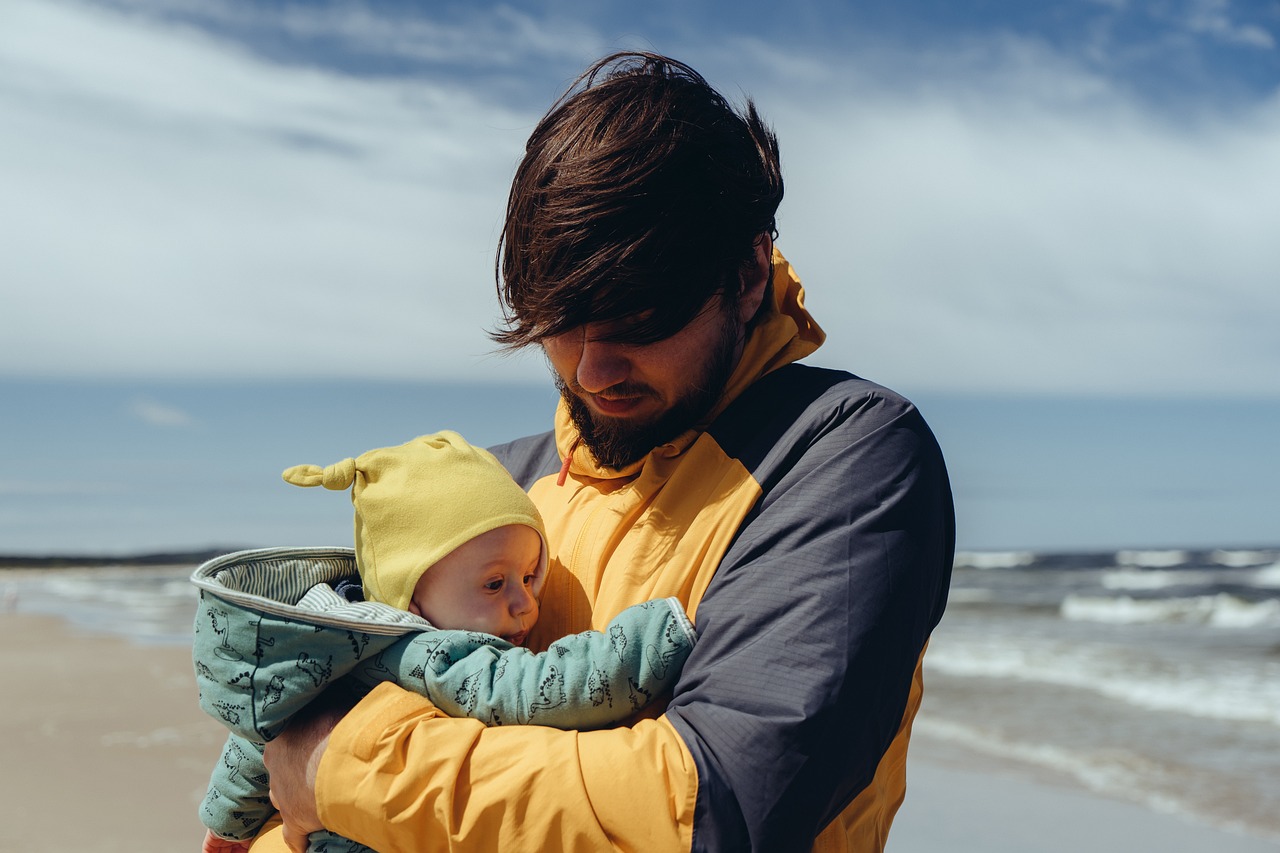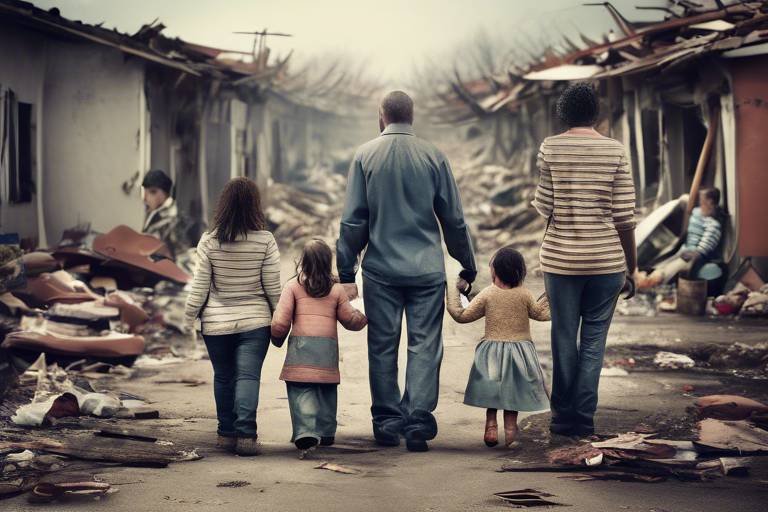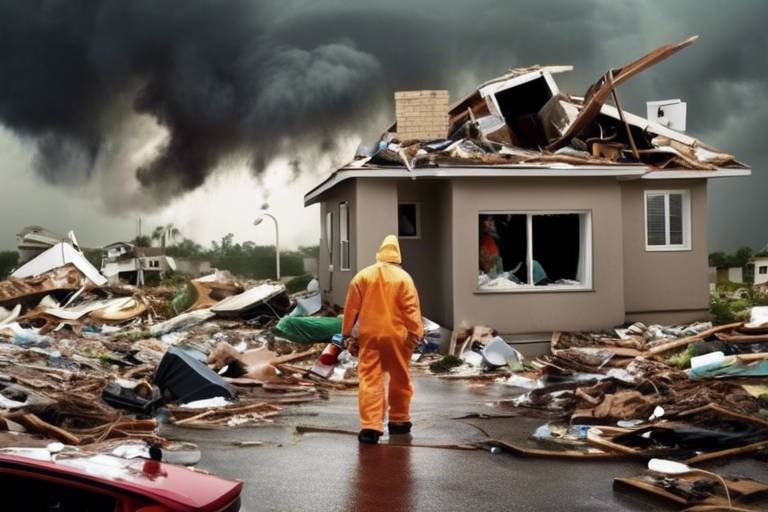Planning for a Family Reunification Post-Disaster
When disaster strikes, the chaos that ensues can be overwhelming, leaving families fractured and searching for one another amidst the turmoil. Planning for family reunification post-disaster is not just a logistical necessity; it’s a crucial emotional lifeline. Imagine the relief of finally reuniting with loved ones after a harrowing experience—this is why having a solid plan in place is essential. By emphasizing preparedness, communication, and resource management, families can ensure that they are not just surviving, but thriving in the aftermath of a disaster.
In the wake of a disaster, emotions run high. The fear of the unknown can be paralyzing, and the thought of being separated from family members can add to that anxiety. Thus, prioritizing family reunification should be at the forefront of any disaster response strategy. It’s about more than just physical safety; it’s about emotional healing and support. When families are together, they can share their experiences, provide comfort, and work through the challenges of recovery together. This article explores various strategies and considerations to help families effectively reunite after a disaster.
To kick off your planning, it’s essential to think about the various scenarios that could unfold. Will you have access to your usual communication tools? What if the roads are blocked? By contemplating these questions, you can create a robust family emergency plan that covers all bases. This plan should not only outline the steps to take during a disaster but also clarify each family member's roles and responsibilities. Ensuring that everyone is on the same page can significantly reduce panic and confusion when it matters most.
In the next sections, we will delve deeper into the importance of establishing effective communication channels, utilizing technology, and leveraging community resources to facilitate reunification. Additionally, we will discuss the significance of practicing family reunification drills, identifying safe locations for reunification, and the necessity of regularly updating your plans. By taking these proactive steps, families can enhance their resiliency and ensure a smoother reconnection process in the face of adversity.
- What should be included in a family emergency plan? A family emergency plan should include contact information for all family members, designated meeting points, and specific roles for each person during a disaster.
- How can technology assist in family reunification? Various apps and platforms can help families stay connected and locate each other during a disaster, such as emergency communication apps and social media channels.
- Why is practicing reunification drills important? Regular drills prepare families for real-life scenarios, ensuring that everyone knows what to do and where to go in case of an emergency.

Understanding the Importance of Family Reunification
In the aftermath of a disaster, the emotional and psychological toll can be overwhelming. Families often find themselves separated amidst chaos, and the urgency to reunite becomes not just a logistical challenge but a vital component of recovery. Family reunification is essential for providing emotional support, fostering resilience, and facilitating healing. Imagine being in a situation where you have lost sight of your loved ones during a natural disaster; the anxiety and fear can be paralyzing. Reconnecting with family members can significantly mitigate these feelings, allowing individuals to focus on recovery rather than despair.
Moreover, the process of reunification plays a crucial role in the overall disaster response strategy. When families are together, they can share resources, make joint decisions, and provide comfort to one another. This collective strength is invaluable during times of crisis. According to studies, families that reunite quickly after a disaster report better mental health outcomes and a greater sense of security. It’s not just about finding each other; it’s about rebuilding a sense of normalcy and safety.
Incorporating family reunification into disaster response plans should be a priority for authorities and organizations. By establishing clear protocols and communication channels, communities can ensure that families can locate each other swiftly. Here are some key reasons why family reunification should be prioritized:
- Emotional Stability: Being with loved ones provides comfort and reduces anxiety during traumatic events.
- Resource Sharing: Families can pool their resources, making it easier to navigate the aftermath of a disaster.
- Improved Recovery: Quick reunification can lead to faster emotional and physical recovery for all family members.
Ultimately, the goal of any disaster response should be to restore not just the physical but also the emotional well-being of affected individuals. By understanding the importance of family reunification, we can better prepare ourselves and our communities for the challenges that lie ahead. It’s not merely about reuniting; it’s about rebuilding lives, one family at a time.

Creating a Family Emergency Plan
When it comes to ensuring the safety and well-being of your loved ones, creating a family emergency plan is not just a good idea; it's essential. Imagine a disaster strikes—whether it's a natural calamity like a hurricane or an unforeseen event like a fire. In those moments of chaos, having a structured plan can mean the difference between confusion and a coordinated response. So, what should this plan include to ensure that every family member knows their role and responsibilities?
First and foremost, your plan should clearly define communication methods. In a crisis, cell towers might be overloaded, or power outages could disrupt your usual means of contact. It’s wise to establish alternative ways to reach each other. Consider using a combination of text messaging, social media, and even traditional methods like landlines if available. Make sure everyone in the family knows how to access these channels and understands the importance of keeping their phones charged and ready.
Next, you should designate a central meeting place. This is crucial in case family members get separated. Choose a location that is familiar to everyone, such as a local park or a community center. It’s also important to have a secondary meeting point in case the primary location is compromised. Make sure to practice getting to these locations during family outings, so everyone knows the route. It’s like a treasure hunt, but the prize is safety!
Another significant component of your plan should be an inventory of emergency supplies. This includes food, water, first aid kits, and any necessary medications. Consider creating a checklist to ensure that your supplies are stocked and ready to go at a moment's notice. Regularly check expiration dates and replenish items as needed. You might even want to involve your kids in this process; it can be a fun way to teach them about preparedness while also ensuring that they feel involved in the family’s safety.
Additionally, it’s wise to assign roles to each family member. For instance, designate one person as the communicator who will relay information to others, while another could be responsible for gathering supplies. This way, everyone knows what they’re supposed to do, and it minimizes panic during an emergency. You can create a simple table to outline these roles, making it easy for everyone to remember their responsibilities:
| Family Member | Role |
|---|---|
| Mom | Communicator |
| Dad | Supply Gatherer |
| Child 1 | Pet Care |
| Child 2 | First Aid Assistant |
Finally, don't forget to review and practice your emergency plan regularly. Just like any other skill, the more you practice, the better prepared you'll be. Set aside time during family gatherings to go over your plan, and even conduct drills. It’s a great way to ensure everyone feels confident and knows what to do when the unexpected happens.
Creating a family emergency plan is an investment in your family's safety and peace of mind. By taking the time to prepare, you’re not just planning for disaster; you’re also fostering a sense of unity and resilience within your family. Remember, it’s not about if a disaster will happen, but when. So, why not be ready?

Establishing Communication Channels
When disaster strikes, establishing effective communication channels is not just a luxury; it's a necessity. Imagine being separated from your loved ones during a chaotic event—it's a nightmare scenario. That's why having a solid plan for staying in touch can make all the difference. Here’s how you can set up reliable communication pathways to ensure that every family member knows how to reach one another, regardless of the circumstances.
First and foremost, it's essential to identify the various communication methods available to your family. Traditional means like phone calls and text messages may become unreliable during disasters due to network overload. Therefore, consider incorporating alternative methods such as:
- Social Media: Platforms like Facebook and Twitter can serve as a lifeline. Many people post updates about their safety, and these platforms often have features that allow users to mark themselves safe during emergencies.
- Messaging Apps: Applications like WhatsApp or Signal can be more effective than standard SMS, especially if they use internet connections to send messages. These apps can work even when cellular networks are down.
- Walkie-Talkies: For immediate communication, especially in localized areas, two-way radios can be invaluable. They don’t rely on cellular networks and can be used to communicate over short distances effectively.
In addition to these methods, it's crucial to establish a designated contact person outside your immediate area. This person can serve as a central point of contact for your family. If everyone is trying to reach each other, it can create confusion. Instead, designate one person who can receive messages from different family members and relay information. This way, if someone can’t reach their family directly, they can contact this designated person to provide updates about their safety.
Moreover, regular communication drills can help reinforce these strategies. Just like fire drills in schools, practicing how to communicate during a disaster can prepare everyone for the real thing. Make it a family activity—discuss the different communication methods and practice using them. This not only helps everyone remember what to do but also builds confidence in the plan.
Lastly, don't forget to keep your communication tools charged and accessible. In an emergency, every second counts, and having a fully charged phone or a set of walkie-talkies ready to go can be the difference between reaching your loved ones and being left in the dark. Consider investing in portable chargers and regularly check that your devices are in working order.
In conclusion, establishing effective communication channels is a cornerstone of family reunification plans. By leveraging various communication methods, designating a contact person, conducting regular drills, and ensuring that your tools are ready, you can significantly enhance your family's chances of staying connected during a disaster. Remember, the goal is to minimize confusion and maximize safety, so take the time now to create a robust communication strategy that will serve your family well when it matters most.

Using Technology for Reunification
In today's digital age, technology can be a lifesaver when it comes to family reunification after a disaster. Imagine the chaos of a natural calamity—everyone is on edge, and the last thing you want is to be separated from your loved ones. Thankfully, there are numerous tools and platforms designed to help families locate each other swiftly and efficiently. From mobile apps to social media, the options are vast, and leveraging these resources can make a significant difference in your reunification efforts.
One of the most effective ways to ensure you can connect with your family during a crisis is to utilize dedicated apps designed for emergencies. For instance, applications like “Find My Family” or “Life360” allow family members to share their locations in real-time. This feature can be invaluable during a disaster when every second counts. Imagine being able to see exactly where your loved ones are on a map, eliminating the guesswork and anxiety that usually accompanies such situations.
Moreover, social media platforms can also play a crucial role in the reunification process. Many individuals turn to platforms like Facebook or Twitter to post their status during emergencies. For example, the “Safety Check” feature on Facebook allows users to mark themselves as safe, letting their friends and family know they are okay. This not only helps to reduce the number of frantic calls and messages but also serves as a public announcement that can reach a wider audience. Isn’t it comforting to know that a simple post can ease the worries of those who care about you?
In addition to apps and social media, there are also websites dedicated to helping people find missing family members after disasters. For instance, the National Center for Missing & Exploited Children provides resources and support for families trying to reunite. These platforms often compile lists of individuals who have been reported missing or found, acting as a central hub for information. Utilizing these resources can significantly enhance your chances of a swift reunion.
It’s crucial to remember that while technology can aid in reunification, it should not be the only strategy you rely on. Having a comprehensive family emergency plan that incorporates these technological tools is essential. Ensure that all family members are familiar with the apps and platforms you choose to use. Regularly check that everyone’s devices are functional and updated with the latest versions of these apps. After all, technology is only as good as its usability!
In conclusion, incorporating technology into your family reunification strategy is not just a modern convenience; it’s a necessity in today’s world. By utilizing apps, social media, and dedicated websites, you can drastically improve your chances of reuniting with your loved ones during a crisis. As you prepare for potential emergencies, make sure to embrace these tools and ensure everyone in your family is on the same page. Together, you can face any disaster with confidence, knowing that you have a plan in place.
- What apps are best for family reunification during a disaster? Apps like “Find My Family” and “Life360” are excellent for real-time location sharing.
- How can social media assist in reunification? Platforms like Facebook allow users to mark themselves as safe and share updates with family and friends.
- Are there websites dedicated to finding missing family members? Yes, organizations like the National Center for Missing & Exploited Children provide resources for locating missing individuals.
- What should I include in my family emergency plan regarding technology? Ensure all family members are familiar with the apps you choose and regularly check that their devices are updated.

Community Resources and Support Systems
When disaster strikes, the importance of community resources and support systems cannot be overstated. These networks act as lifelines, providing essential services that can help families reunite and recover. Think of your community as a safety net; when one thread frays, the others hold strong, ensuring that no one falls through the cracks. Local organizations, shelters, and volunteer groups often mobilize quickly, offering assistance in the form of food, shelter, medical care, and emotional support. They are like the first responders of community care, ready to step in when families are at their most vulnerable.
One of the first things you should consider is how to tap into these resources effectively. Many communities have established disaster response teams that coordinate efforts during emergencies. These teams often include local law enforcement, fire departments, and non-profits dedicated to disaster relief. They work together to create a comprehensive support system that can assist families in locating each other. For example, local shelters may serve as designated reunification points where families can gather, share information, and receive updates on missing loved ones.
Moreover, many communities have developed online platforms and social media groups dedicated to disaster response. These digital spaces can be invaluable for real-time updates and information sharing. Imagine being able to post a message about your whereabouts or a missing family member, and having your community rally together to help. It's like having a virtual town square where everyone can come together to lend a hand. Here are some community resources you might consider:
- Local Shelters: Often set up in schools or community centers, these can be safe places for families to meet.
- Non-Profit Organizations: Groups like the Red Cross or local charities often provide support and resources during emergencies.
- Community Centers: These can serve as information hubs where families can receive updates and assistance.
- Social Media Groups: Platforms like Facebook can provide updates and help connect families in real-time.
It's crucial to familiarize yourself with these resources before a disaster occurs. By knowing where to turn for help, you can save precious time and reduce stress when you need it the most. Additionally, participating in community preparedness programs can strengthen these support systems. When communities come together to plan and prepare, they build resilience. This collective effort not only enhances the ability to respond to disasters but also fosters a sense of belonging and mutual support.
In summary, community resources and support systems play a vital role in family reunification after a disaster. They provide the necessary infrastructure for families to find each other amidst chaos. By leveraging local organizations and staying connected through digital platforms, families can enhance their chances of a swift and safe reunion. As the saying goes, "It takes a village," and in times of crisis, that village becomes even more critical.
Q: What should I do if I can't find my family after a disaster?
A: First, check local shelters and community centers where families may gather. Utilize social media and community apps to post about your missing family members. Stay in touch with local authorities for updates.
Q: How can I prepare my family for a disaster?
A: Create a family emergency plan that includes communication methods, designated meeting points, and a list of important contacts. Regularly review and practice this plan with all family members.
Q: What resources are available for emotional support after a disaster?
A: Many community organizations offer counseling services and support groups for families affected by disasters. Check with local non-profits or mental health services for available resources.

Practicing Family Reunification Drills
When disaster strikes, the chaos can be overwhelming. The last thing you want is to be scrambling to remember your family reunification plan while the world around you is in disarray. This is where becomes essential. Think of it like a fire drill at school; you don’t want to learn the exits when the smoke is already filling the room. By regularly conducting reunification drills, families can ensure that everyone knows exactly what to do, where to go, and how to communicate in a crisis.
So, how can families effectively practice these drills? First, it's important to establish a clear and concise reunification plan. This plan should outline specific meeting points and communication methods. For instance, you might decide on a local park as your primary meeting spot. During your drills, make sure to visit this location together, noting potential obstacles like traffic patterns or construction that could impact accessibility during a real emergency.
Next, incorporate realistic scenarios into your drills. You might simulate different types of disasters, such as a natural disaster like an earthquake or a man-made incident like a fire. Each scenario will require a different response, and practicing these variations will prepare your family for the unexpected. For example, you could set a timer and challenge family members to reach the designated reunification point within a specific timeframe. This not only adds an element of urgency but also makes the drill more engaging.
Moreover, communication is key during these drills. Make sure that every family member knows how to reach each other before, during, and after a disaster. You might want to use a combination of methods, such as:
- Text messages for quick updates
- Social media for broader announcements
- Emergency apps that can help locate loved ones
By practicing these communication methods during your drills, you can identify any potential issues and adjust your plan accordingly.
Finally, after each drill, take some time to discuss what went well and what could be improved. This reflection is crucial for refining your reunification strategy. You might even consider keeping a log of your drills, noting the date, participants, and any lessons learned. Over time, this record can help you adapt your plan to changing family dynamics or new information about local hazards.
In conclusion, practicing family reunification drills is not just a checkbox on a preparedness list; it's a vital component of ensuring your family's safety in the event of a disaster. The more familiar everyone is with the plan, the less likely panic will set in when it matters most. So gather your family, create a plan, and start practicing—because when disaster strikes, every second counts.

Identifying Safe Reunification Locations
When disaster strikes, the chaos that ensues can leave families feeling lost and anxious. One of the most crucial steps in the reunification process is identifying safe locations where family members can gather. These locations serve as a beacon of hope amidst the turmoil, providing a sense of security and a plan to follow. But how do you go about choosing these vital meeting points? It’s not just about picking a place on the map; it’s about considering various factors that can make or break the success of your reunification efforts.
First and foremost, accessibility is key. Imagine trying to reach a designated meeting spot that is completely blocked off or inaccessible due to debris or flooding. That’s why it’s essential to select locations that are not only easy to access but also safe from potential hazards. Think about nearby parks, community centers, or even the local school as possible options. These places typically have open spaces and can accommodate larger groups, making them ideal for family reunification.
In addition to accessibility, you should also consider the safety of the chosen locations. This means evaluating the surrounding environment for potential dangers such as ongoing fires, flooding, or unstable structures. Before finalizing a reunification point, take a moment to assess the area. Is it well-lit? Are there any security measures in place? Is it far enough away from the disaster’s epicenter? These questions are crucial in ensuring that your family can reunite without additional risks.
Another critical factor to keep in mind is the potential for overcrowding. In the aftermath of a disaster, many people will be seeking safety and reunification, which can lead to crowded conditions. If you choose a location that is too small or not well-known, you might find yourself in a situation where it’s impossible to locate your loved ones. To combat this, consider having multiple designated locations based on different scenarios. For example, if your first choice is too crowded, where will you go next? This redundancy can save valuable time and reduce stress.
It's also wise to keep a list of these locations handy. You can create a simple table that outlines each potential meeting point along with its accessibility and safety features. Here’s a brief example:
| Location | Accessibility | Safety | Notes |
|---|---|---|---|
| Local Park | Easy access via main road | Low flood risk | Spacious, good visibility |
| Community Center | Accessible by public transport | Security presence | Can accommodate large groups |
| High School | Near main highway | Far from disaster zone | Familiar to most families |
Finally, it’s essential to communicate these plans with all family members. Make sure everyone knows the designated meeting points and the reasons behind your choices. Regularly discussing these locations helps ensure that, in the heat of the moment, no one is left guessing where to go. Remember, the goal is to make reunification as smooth and stress-free as possible.
By taking the time to identify safe reunification locations, you’re not just planning for a disaster; you’re creating a lifeline for your family. It’s about turning chaos into order, providing a clear path for your loved ones to follow when it matters most. So, give it the thought and attention it deserves, and you’ll be one step closer to ensuring your family’s safety in uncertain times.
- What should I consider when choosing a reunification location? Look for accessibility, safety, and the potential for overcrowding.
- How often should I update my reunification plan? Regularly review and update your plan to reflect any changes in your family dynamics or local conditions.
- Can I have multiple reunification locations? Yes, having several options is advisable in case your primary location becomes inaccessible.

Accessibility and Safety of Locations
When planning for family reunification after a disaster, the accessibility and safety of chosen locations are paramount. Imagine a scenario where a family is scattered across different areas due to a natural disaster. The last thing you want is for your designated meeting point to be hard to reach or, worse, unsafe. Therefore, selecting locations that are both easy to access and secure can make all the difference in the world.
Firstly, consider the proximity of the reunification site to your home or the areas where family members are likely to be. Ideally, the location should be within a reasonable distance that can be traveled on foot or by vehicle, depending on the situation. For instance, if a family lives in a suburban area, a local park or community center could serve as a suitable meeting point. On the other hand, urban dwellers might find public libraries or schools to be more accessible.
Moreover, transportation options play a crucial role. In the aftermath of a disaster, roads may be blocked, and public transportation may be limited. Therefore, it's wise to choose locations that are accessible by multiple means. This could include locations near major roads, bus routes, or even areas that are known for being safe havens during emergencies. By ensuring that your reunification site is reachable through various modes of transport, you enhance the likelihood of a successful reunion.
Safety is another critical factor to consider. When evaluating potential meeting points, think about the security of the area. Is it in a well-lit location? Are there any potential hazards nearby, such as downed power lines or unstable buildings? Ideally, the site should be away from areas prone to flooding or other natural disasters. Additionally, consider the potential for overcrowding. In high-stress situations, such as a disaster, people often flock to familiar places, which can lead to chaos. By choosing a location that can accommodate your family while still allowing for some space, you can create a more manageable situation for everyone involved.
To aid in the decision-making process, it might be helpful to create a table that outlines potential reunification locations along with their accessibility and safety features. Here’s a simple example:
| Location | Accessibility | Safety Features |
|---|---|---|
| Local Park | Within walking distance | Well-lit, monitored |
| Community Center | Accessible by bus | Security personnel on site |
| Public Library | Near major roads | Safe from flood zones |
In conclusion, when identifying safe reunification locations, prioritize both accessibility and safety. By doing so, you not only enhance the chances of a successful family reunion but also bring peace of mind during uncertain times. Remember, the goal is to create a plan that allows your family to reconnect swiftly and safely, ensuring that emotional support is readily available when it’s needed most.
- What should I consider when choosing a reunification location? Look for accessibility, safety, and the potential for overcrowding.
- How often should I review my reunification plan? Regularly, especially after any significant changes in family dynamics or local infrastructure.
- What if my family members are in different locations? Establish multiple meeting points that are accessible from various areas.

Updating Reunification Plans Regularly
When it comes to family reunification plans, stagnation is the enemy. Just like a car needs regular maintenance to run smoothly, your family’s emergency plan requires periodic updates to remain effective. Life is unpredictable, and changes in circumstances—like new family members, relocations, or shifts in communication preferences—can impact how your family will respond during a disaster. Think of your reunification plan as a living document that evolves with your family dynamics.
Regularly reviewing and updating your plan ensures that everyone is on the same page and understands their roles and responsibilities. This is especially important because, during a crisis, confusion can lead to chaos. Imagine trying to navigate a maze blindfolded; without a clear plan, it’s easy to get lost. To avoid this, consider scheduling a family meeting at least once a year to discuss and practice your reunification strategy. During these meetings, you can:
- Assess any changes in your family situation, such as new addresses or phone numbers.
- Review the effectiveness of your current communication methods.
- Discuss any new technologies that could facilitate reunification.
- Re-evaluate your designated meeting points based on recent community developments.
Moreover, it’s crucial to keep an eye on local disaster response protocols and community resources. If your town has updated its emergency services or if there are new shelters available, you’ll want to incorporate that information into your plan. Think of it as tuning into the latest weather report before heading out; staying informed can make all the difference. Additionally, if your family has experienced significant life changes—like a child going off to college or a relative moving away—these factors should also influence how you update your reunification strategy.
Another key aspect of updating your plan is to ensure that all family members are aware of the changes. This means not only sharing the updated plan but also practicing it. After all, it’s one thing to have a plan written down, but it’s another to put it into action. Regular drills can help reinforce the updated procedures and build confidence in each family member's ability to respond effectively during an emergency. Remember, the goal is to eliminate uncertainty and foster a sense of security. With a well-practiced plan, your family can face any disaster with courage and clarity.
In conclusion, updating your family reunification plans regularly is not just a good practice; it’s essential for ensuring everyone’s safety and peace of mind. By keeping your plans current and practicing them, you’re not only preparing for the worst but also strengthening the bonds of your family. After all, in times of crisis, it’s the connections we have with each other that truly matter.
Q: How often should we update our family reunification plan?
A: It’s recommended to review and update your plan at least once a year, or whenever there are significant changes in your family situation or local emergency protocols.
Q: What should we do if a family member is unable to reach the designated meeting point?
A: Discuss alternative meeting points during your family meetings and ensure everyone knows how to communicate if plans change.
Q: Are there specific apps that can help with family reunification?
A: Yes, there are several apps designed for emergency communication and location sharing, such as Life360 or Red Cross Emergency App. Make sure everyone in your family is familiar with these tools.
Frequently Asked Questions
- Why is family reunification important after a disaster?
Family reunification is crucial because it provides emotional support and helps individuals recover from the traumatic effects of a disaster. When families are together, they can share resources, make informed decisions, and support each other through the recovery process.
- What should be included in a family emergency plan?
A family emergency plan should include clear roles and responsibilities for each family member, communication methods, designated meeting points, and contact information for local resources. It’s essential to ensure that everyone understands the plan and knows what to do in case of an emergency.
- How can families maintain communication during a disaster?
Families can maintain communication by using multiple channels such as text messages, social media, and emergency apps. Establishing a family group chat or using location-sharing features can also help members stay connected and informed during a crisis.
- What technology can assist in family reunification?
There are several apps and platforms designed for disaster response, such as FEMA’s app, which provides emergency updates and resources. Other options include social media platforms and specialized reunification services that help families locate each other during emergencies.
- How can community resources aid in reunification?
Community organizations and local services can provide essential support during reunification efforts. They often have resources such as shelters, food, and medical assistance, as well as information on where to find missing family members.
- Why are reunification drills important?
Practicing family reunification drills prepares everyone for real-life scenarios, ensuring that each member knows their role and the steps to take during an emergency. Regular practice can reduce panic and confusion, making the reunification process smoother.
- What factors should be considered when choosing reunification locations?
When selecting reunification locations, consider accessibility, safety, and potential overcrowding. Choose locations that are easy to reach, secure, and have enough space for your family to gather without feeling cramped or unsafe.
- How often should family reunification plans be updated?
Family reunification plans should be reviewed and updated regularly to reflect changes in family dynamics, new information, or shifts in local resources. Keeping the plan current ensures that it remains effective and relevant when a disaster strikes.



















